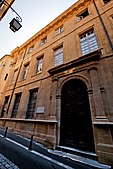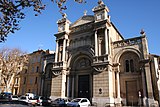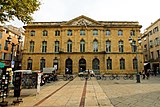Laurent Vallon
Laurent Vallon | |
|---|---|
| Born | 1652 |
| Died | 1724 |
| Nationality | French |
| Occupation | Architect |
| Children | Georges Vallon |
Laurent Vallon (1652-1724) was a French architect, mostly active in the Provence. Many of his buildings are now listed as monuments historiques.
Biography[]
Early life[]
Laurent Vallon was born in 1652. He received his training from Jacques and Jean Drusian.[1]
Career[]
He designed several Hôtel particuliers. In Aix-en-Provence, he was commissioned by (1674-1746) to design the with , which is listed as Monument historique.[2] It is located on the , which was designed by his son Georges and is also listed.[3] Together with Jean Daret and Jean Jaubert, he also designed the located at 10 rue du Quatre-Septembre, also listed.[4] He also designed the facade of the Hôtel de Grimaldi-Régusse, a listed building located at 26, rue de l'Opéra.[5]
Additionally, he designed several Roman Catholic convents and a church. Together with and , he designed the located on the rue Cardinale, then two Roman Catholic convents known as Couvent des Bénédictines (for the Order of Saint Benedict) and Couvent des Ursulines (for the Ursulines); it is listed.[6] On his own, he designed another convent, this time for the Jesuits, known as the located at 20 rue Lacépède, which is also listed.[7][8] Additionally, with (1658-1736), he designed the Chapel of the Oblates located at 52-60 Cours Mirabeau, also listed.[9] Moreover, he designed the Église de la Madeleine in Aix, which was built from 1691 to 1703.[10][11][12] He also designed the Église Saint-Jean-Baptiste du Faubourg, located at 36 cours Sextius in Aix, built from 1697 to 1702, and listed since 1983.[13][14]
With his son, he designed the , another listed building since 1983, which was built from 1717 to 1759 and now houses a post office and a library.[15]
In Marignane, together with Jean Daret, he designed the , which now serves as the townhall, also listed.[16]
Personal life[]
He had a son, Georges Vallon (1688-1767), who was also a renowned architect. He died in 1724.
Gallery[]

Hôtel d'Albertas (designed with Jean Lombard) in Aix-en-Provence

Hôtel d'Olivary (designed with Jean Daret and Jean Jaubert) in Aix-en-Provence

Hôtel de Grimaldi-Régusse in Aix-en-Provence, whose facade he designed
Collège Mignet, formerly the Couvent des Bénédictines and the Couvent des Ursulines, (designed with Joseph Jaubert and Jean Vallon) in Aix-en-Provence
Couvent des Jésuites in Aix-en-Provence
Facade of the Chapel of the Oblates in Aix-en-Provence

Église de la Madeleine (facade by Henri Révoil) in Aix-en-Provence
Église Saint-Jean-Baptiste du Faubourg in Aix-en-Provence

Halle aux grains (designed with his son) in Aix-en-Provence
References[]
- ^ Inès Castaldo, Le Quartier Mazarin. Habiter noblement à Aix-en-Provence. XVIIe ‑ XVIIIe siècles, colloque « Le Temps de l'Histoire », Aix-en-Provence: Publications de l'Université de Provence, 2011, p. 193
- ^ Base Mérimée: Hôtel d'Albertas, Ministère français de la Culture. (in French)
- ^ Base Mérimée: Immeubles formant la place d'Albertas, Ministère français de la Culture. (in French)
- ^ Base Mérimée: Hôtel d'Olivary dit aussi hôtel Paradis ou hôtel de Silvacane ou Revest-de-Montvert ou Pignet-Guelton, Ministère français de la Culture. (in French)
- ^ Culture 13: Hôtel de Grimaldi-Régusse Archived 2013-12-18 at the Wayback Machine
- ^ Base Mérimée: Couvent des Bénédictines et couvent des Ursulines (anciens) , actuellement collège Mignet, Ministère français de la Culture. (in French)
- ^ Base Mérimée: Couvent des Jésuites (ancien), Ministère français de la Culture. (in French)
- ^ Jean-Jacques Gloton, Bibliothèque des écoles francaises d'Athènes et de Rome, E. de Boccard, 1979, Volume 237, Issue 2, p. 336 [1]
- ^ Base Mérimée: Ancien couvent des Carmélites, actuel couvent des Oblats, Ministère français de la Culture. (in French)
- ^ Base Mérimée: Eglise de la Madeleine, ou ancienne église des Prêcheurs, Ministère français de la Culture. (in French)
- ^ Liliane Counord, Jean-Paul Labourdette, Gérard Bernar, Dominique Auzias, Provence, Le Petit Futé, 2010, p. 166 [2]
- ^ Dominique Auzias, Jean-Paul Labourdette, Provence, Le Petit Futé, 2013, p. 172 [3]
- ^ Aix-en-Provence Tourism: Église Saint-Jean-Baptiste du Faubourg
- ^ Culture 13
- ^ Albert Aynaud, Aix-en-Provence, ses fontaines et leurs secrets, 10, bd Roi-René, 1969, p. 77 [4]
- ^ Base Mérimée: Ancien château des Covet de Marignane, actuel hôtel de ville, Ministère français de la Culture. (in French)
- 1652 births
- 1724 deaths
- People from Aix-en-Provence
- 17th-century French architects
- 18th-century French architects








